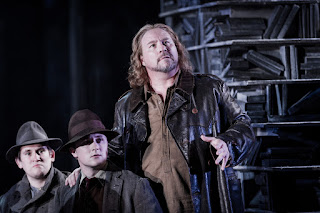 |
| Carl Tanner & ensemble - Samson et Dalila - Grange Park Opera - photo credit Robert Workman |
Reviewed by Robert Hugill on Jun 28 2015
Star rating:
Imaginative re-casting of Saint-Saens biblical epic
 |
| Sara Fulgoni photo credit Robert Workman |
At Grange Park Opera, Patrick Mason's new production faced the work's difficulties head one by completely avoiding the biblical setting and translating it to the period of intense anti-semitism in the Vichy Republic in France. The translocation required a bit a suspension of disbelief but the main thrust of the plot was brilliantly handled with a superb theatrical coup at the end. And Francis O'Connor set the piece in some highly stylish designs.
Carl Tanner sang Samson, with Sara Fulgoni as Dalila (now something of a celebrity filmstar), Nicholas Folwell as Abimelech, Christophoros Stamboglis as the Old Hebrew (now the Rabbi), Michel de Souza as the High Priest of Dagon (now the head of the local SS), with Edmond Choo, Roberto Abate, Matthew Thistleton and Carter Jeffries. Patrick Mason directed, with designs by Francis O'Connor, choreography by Nikki Woollaston and lighting by Paul Keogan.
 |
| Carl Tanner, Sara Fulgoni -photo credit Robert Workman |
I have to confess that I found the first couple of acts did not really catch fire. There were good moments, the chorus of 28 worked hard and make a good thrilling, firm sound, and Carl Tanner as Samson sounded suitably heroic. Whilst Sara Fulgoni was voluptuously statuesque as Dalila, and Michel de Souza made a briskly scary High Priest. But, though conductor Gianluca Marciano was working hard, and clearly loves the score, much of the recitative felt heavy, sluggish almost. Neither Carl Tanner nor Sara Fulgoni were ideal.
 |
| Carl Tanner - photo credit Robert Workman |
All this changed in Act Three. With his opening aria, Voi ma misere Carl Tanner found the right heroic form, singing with passionate, intense and firm tone. The whole act built in one single dramatic crescendo, helped by the theatrical logic of the re-interpretation of the bacchanale. Having the blind Samson led round by a young boy dressed as a scout-like neo-Hitler youth, Carter Jeffries, clearly sympathetic to him, was a brilliant touch. The ending, again with an element of fuzzy logic, with is brilliant Cordelia Parker-like explosion of the set was a strong final image. (One last quibble, Samson effected the destruction via an explosive device rather than a sudden miracle).
 |
| Michel de Souza, Edmond Choo - photo credit Robert Workman |
As I have suggested, Gianluca Marciano drew virile playing from the Bournemouth Symphony Orchestra, and created a strong dramatic thrust particularly in Act Three. The real lushness of the score came over, with lots of detail in Saint-Saens imaginative orchestrations, but I did miss a sense of flexible French line and style. (It is well worth trying to get hold of George Pretre's recording
Saint-Saens opera is a big dramatic work requiring significant resources and the production at Grange Park Opera, in Patrick Mason and Francis O'Connor's imaginative recasting, was a notable achievement. But heroic voices rarely sing French 19th century opera nowadays with the requisite feel for style and it was this which you felt lacking. That and the lack of erotic charge between principals were compensated for by the sustained drama of the final act.
Elsewhere on this blog:
- Satisfying balance: La Bohème at Grange Park - opera review
- Virtuosity with a human touch: My encounter with Matthew Sharp, cellist, baritone, director, creative director of Revelation St Mary's, artist in association with the English Symphony Orchestra - interview
- Brilliant personal vision: Le Concert Spirituel in Vivaldi and Campra - concert review
- Strong musical performance: Opera Holland Park's first Aida - opera review
- Into the 20th century: Mahan Esfahani - CD review
- Vibrant conclusion: The Cardinall's Musick in Robert Fayrfax - concert review
- Look no microphones: Fiddler on the Roof with Bryn Terfel - opera review
- Mesmerising: Mark Padmore & Roger Vignoles in Britten & Schubert - concert review
- Last Russian sacred music written in Soviet Russia: Maximilian Steinberg Passion Week - CD review
- Beginnings and endings: Director Paul Curran on Death in Venice at Garsington - Interview
- From Mexico with style: Jesus Leon Bel Canto - CD review
- Storm! Choral music of Judith Weir from the BBC Singers - CD review
- Home











No comments:
Post a Comment